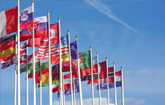Movement for Korean Unification Grows Ahead of Centennial Celebration of March 1, 1919 Independence Movement
Experts Say Moving Beyond the Cold War Framework is Essential for Peace on the Korean Peninsula
WASHINGTON, Feb. 25, 2019 /PRNewswire/ -- The division of the Korean peninsula following the conclusion of World War II arose out of Cold War calculations and had "nothing to do with the aspirations of the Korean people," Global Peace Foundation Chairman Dr. Hyun Jin Preston Moon told a recent international forum in Washington, DC.
Korea experts at the December 2018 Carnegie Institution for Science forum examined current events and opportunities presented for reunification of the Korean peninsula. Noting the approaching centennial of the March 1, 1919 Korean Independence movement from Japanese occupation, Moon said the ideals of that movement for national sovereignty and self-determination "based upon Korea's shared cultural history" are in alignment with a growing movement for the peaceful Korean reunification, which is the stated goal of both North and South Korea and hope of all Koreans.
Forum moderator Richard Lee called the continuing division of the Korean peninsula "a vestige of the Cold War" and said unification presented a "third way" to military confrontation or acceptance of a nuclear-armed North Korea.
Lee also announced that the One Korea Global Campaign, an initiative of the Global Peace Foundation and the Alliance for Korea United, will bring international attention to the growing movement for Korean reunification with a program of events in Seoul from February 26-March 1, 2019.
The schedule includes a conference of international scholars and policymakers, a One Korea Concert, a documentary film, art and poetry competitions, and a culminating Centennial celebration in central Seoul. The One Korea Global Campaign is building international popular support to end the Cold War division and advance a vision of a unified, non-aligned Korea based on the values, traditions and heritage shared by all Koreans.
- Learn more about the March 1st centennial events in Seoul.
A divided history
The two Koreas have evolved into starkly different societies since the end of the Korean War, which followed repeated outbreaks of armed conflict along the border after the division of Korea following Japanese surrender in World War II. North Korean forces invaded South Korea on June 25, 1950 in an attempt to unify Korea by force, triggering the Korean War. Backed by Soviet military, the North overran much of the South until a U.S.-led, UN-authorized military response drove the North Korean invaders back. The armistice ending the Korean War in 1953 reestablished the division of Korea at the 38th parallel and left North and South technically in a state of war.
The divided peninsula has undermined global security, separated a people with a shared history and tradition, and prolonged a humanitarian crisis in the North. Diplomatic initiatives, including the Six-Party Talks aimed at resolving security concerns surrounding North Korea's nuclear weapons program, have led to little progress in bridging the Cold War divide between the two Koreas.
"The goal of a unified Korea, separate from the legacy of the Cold War and based upon Korea's shared cultural history," said Action for Korea United co-chairman Inteck Seo, "is not the work of governments alone but requires a broad civil society coalition."
"All interim issues such as denuclearization would be addressed within that framework," he said. "Peaceful reunification would guarantee global peace and security, opening the door to prosperity in the region and worldwide. Most of all, it will fulfill the first step in realizing the Korean Dream of creating a model nation among nations and fulfilling their national destiny."
Contact: [email protected]
SOURCE Global Peace Foundation
WANT YOUR COMPANY'S NEWS FEATURED ON PRNEWSWIRE.COM?
Newsrooms &
Influencers
Digital Media
Outlets
Journalists
Opted In

Share this article